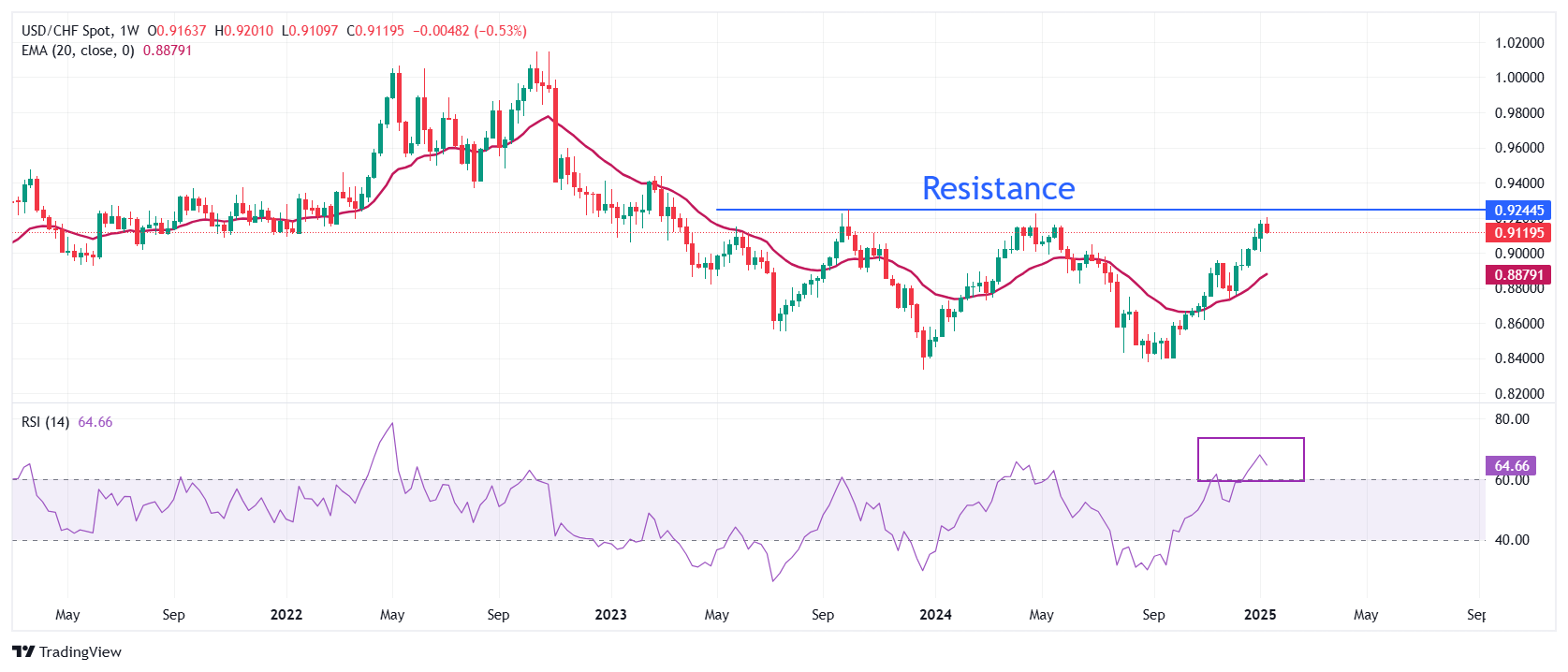- USD/CHF appears to be cautious around 0.9100 with investors focusing on the US inflation data for December.
- The Fed is expected to cut interest rates only once this year.
- Investors expect further policy-easing by the SNB due to growing risks of inflation remaining lower.
The USD/CHF pair trades with caution slightly above the key support of 0.9100 in Wednesday’s European session. The Swiss Franc pair ticks lower as the US Dollar (USD) falls slightly ahead of the United States (US) Consumer Price Index (CPI) data for December, which will be published at 13:30 GMT.
The US Dollar Index (DXY), which gauges the Greenback’s value against six major currencies, drops to near the key support of 109.00.
Investors will pay close attention to the US inflation data, which will indicate how long the Federal Reserve (Fed) will keep interest rates at their current levels this year. According to the CME FedWatch tool, the Fed is expected to cut interest rates only once this year, and that will not happen before June’s policy meeting.
Economists expect the annual headline inflation to have accelerated to 2.9% from 2.7% in November, with the core reading growing steadily by 3.3%.
Meanwhile, the Swiss Franc (CHF) remains under pressure as investors expect the Swiss National Bank (SNB) to continue reducing interest rates to avoid risks of inflation undershooting their 0-2% range.
USD/CHF is on track to revisit its 15-month high, around 0.9200. The outlook of the Swiss Franc pair remains firm as the 20-week Exponential Moving Average (EMA) near 0.8879 is sloping higher.
The 14-week Relative Strength Index (RSI) oscillates in the bullish range of 60.00-80.00, suggesting a strong upside momentum.
For a fresh upside toward the round-level resistance of 0.9300 and the 16 March 2023 high of 0.9342, the asset needs to break decisively above the October 2023 high of 0.9244.
On the flip side, a downside move below the psychological support of 0.9000 would drag the asset towards the November 22 high of 0.8958, followed by the December 16 low of 0.8900.
USD/CHF weekly chart
US Dollar FAQs
The US Dollar (USD) is the official currency of the United States of America, and the ‘de facto’ currency of a significant number of other countries where it is found in circulation alongside local notes. It is the most heavily traded currency in the world, accounting for over 88% of all global foreign exchange turnover, or an average of $6.6 trillion in transactions per day, according to data from 2022. Following the second world war, the USD took over from the British Pound as the world’s reserve currency. For most of its history, the US Dollar was backed by Gold, until the Bretton Woods Agreement in 1971 when the Gold Standard went away.
The most important single factor impacting on the value of the US Dollar is monetary policy, which is shaped by the Federal Reserve (Fed). The Fed has two mandates: to achieve price stability (control inflation) and foster full employment. Its primary tool to achieve these two goals is by adjusting interest rates. When prices are rising too quickly and inflation is above the Fed’s 2% target, the Fed will raise rates, which helps the USD value. When inflation falls below 2% or the Unemployment Rate is too high, the Fed may lower interest rates, which weighs on the Greenback.
In extreme situations, the Federal Reserve can also print more Dollars and enact quantitative easing (QE). QE is the process by which the Fed substantially increases the flow of credit in a stuck financial system. It is a non-standard policy measure used when credit has dried up because banks will not lend to each other (out of the fear of counterparty default). It is a last resort when simply lowering interest rates is unlikely to achieve the necessary result. It was the Fed’s weapon of choice to combat the credit crunch that occurred during the Great Financial Crisis in 2008. It involves the Fed printing more Dollars and using them to buy US government bonds predominantly from financial institutions. QE usually leads to a weaker US Dollar.
Quantitative tightening (QT) is the reverse process whereby the Federal Reserve stops buying bonds from financial institutions and does not reinvest the principal from the bonds it holds maturing in new purchases. It is usually positive for the US Dollar.
Information on these pages contains forward-looking statements that involve risks and uncertainties. Markets and instruments profiled on this page are for informational purposes only and should not in any way come across as a recommendation to buy or sell in these assets. You should do your own thorough research before making any investment decisions. FXStreet does not in any way guarantee that this information is free from mistakes, errors, or material misstatements. It also does not guarantee that this information is of a timely nature. Investing in Open Markets involves a great deal of risk, including the loss of all or a portion of your investment, as well as emotional distress. All risks, losses and costs associated with investing, including total loss of principal, are your responsibility. The views and opinions expressed in this article are those of the authors and do not necessarily reflect the official policy or position of FXStreet nor its advertisers. The author will not be held responsible for information that is found at the end of links posted on this page.
If not otherwise explicitly mentioned in the body of the article, at the time of writing, the author has no position in any stock mentioned in this article and no business relationship with any company mentioned. The author has not received compensation for writing this article, other than from FXStreet.
FXStreet and the author do not provide personalized recommendations. The author makes no representations as to the accuracy, completeness, or suitability of this information. FXStreet and the author will not be liable for any errors, omissions or any losses, injuries or damages arising from this information and its display or use. Errors and omissions excepted.
The author and FXStreet are not registered investment advisors and nothing in this article is intended to be investment advice.
Recommended content
Editors’ Picks

EUR/USD stays in tight range near 1.0400 ahead of US data
EUR/USD moves sideways at around 1.0400 on Thursday. The pair struggles to gain traction as US President Trump's tariff threats against the EU and expectations for a dovish ECB outlook make it difficult for the Euro to find demand ahead of US data.

GBP/USD stabilizes around 1.2300 as USD holds ground
GBP/USD fluctuates near 1.2300 in the second half of the day on Thursday. The pair meets supply as the US Dollar stabilizes and traders digest US President Trump's tariff talks, gearing up for the mid-tier US economic data later in the day.

Gold price sticks to negative bias, remains close to multi-month peak set on Wednesday
Gold price (XAU/USD) remains depressed through the first half of the European session on Thursday and for now, seems to have snapped a three-day winning streak to its highest level since early November touched the previous day.

Bitcoin edges below $102K ahead of mid-tier US data and Trump’s tariff threats
Bitcoin’s (BTC) price continues to decline, trading below $102,000 at the time of writing on Thursday after falling 2.3% the previous day. Later in the day, BTC could expect volatility after the US weekly Initial Jobless Claims data release.

Netflix posts record quarter, as Trump talks tariffs on China
There has been a positive tone to risk this week, as the market digests Trump 2.0. However, Trump is not the only show in town. Earnings reports are also a key driver of stock indices, and the news is good.

Trusted Broker Reviews for Smarter Trading
VERIFIED Discover in-depth reviews of reliable brokers. Compare features like spreads, leverage, and platforms. Find the perfect fit for your trading style, from CFDs to Forex pairs like EUR/USD and Gold.
